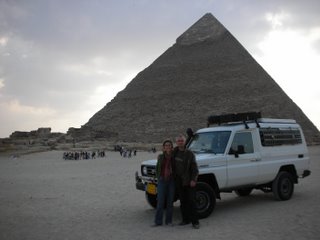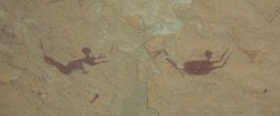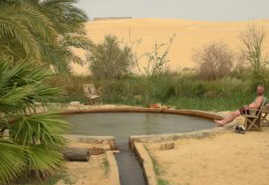![]() Off the Road
through Africa!
Off the Road
through Africa!
Egypt
Alex and Cairo
As we wrote our last report we were relaxing in Alexandria... Back here today, we feel obliged to report on our experiences since.Luckily we will not bore you with administrative issues this time...
Alex, as many people call it, is a nice, windy coastal city. People are friendly and somehow less conservative as they seem to be in Cairo. Having solved the car customs issue, we spent our time being spoiled by Jutta, and her daughter Monica. We tasted Alex's great seafood and fish and experienced other luxuries for us, such visiting the hair-dresser.We then headed for Cairo. We took one day to visit the historic Khan al Khalili quarter, with it's bazaar style shops where we saw the locals in action. It was Friday so the morning was relatively quiet. An interesting experience was to climb the minarets located over an old gate to the market area, enabling a great view over Cairo. Shocking though,
was to realize that most of the roofs in the neighborhood were full of trash. Even heavy things that needed to be carried there such as car tires or parts of old toilets...
In the afternoon we went to the Egyptian Museum, which is a must, even if one ends up with, as the Lonely Planet puts it, severe pharaonic fatigue. We especially enjoyed staying there quite late and being practically alone in the Tutankhamen chamber. Also impressive, although it costs extra, is the Mummies room. There the mummified 3500 year old bodies of 11 pharaohs are displayed, Tuthmosis IV and Ramses II among them. Besides, we really liked some of the less visited rooms, where small models showing daily activities during pharaonic times are displayed.
The first two nights we stayed at Salma Camp, the only sort of camping around Cairo, were we met other overlanders. Ed and Sue, an English couple with a Land Rover who we had met already in the ferry to Tunis, and Kevin and Kristina from Denmark also with a Land Rover. Curiously enough we all have a similar itinerary planed and a similar time schedule. So we most likely will be bumping into each other again.
We also managed to finally visit the Pyramids inside. We arrived late as the night before we had an accident in the car... Our fire extinguisher went off and the whole car interior was coated in white... so we spent most of the day cleaning... As we arrived quite late to the Pyramids we decided to visit Chephren inside, which is usually less crowded as Cheops. There is not much to see inside the pyramids but the experience of walking through the 1,30 m high, meant-to-be-secret corridors gave us an insight of the complexity of it's construction.The trip to the Western Desert
On March 18th our desert trip started. We refilled our water and diesel supplies and visited Carrefour supermarket in order to fill our fridge. Then we took the road to Barharyia oasis were we camped that night.
For us, as we did not have any travel partner with a suitable vehicle, the only way to do such a trip (more than 2000 km without being able to refill fuel and water) was to join a tour as for venturing in such remote places it is not advisable to go alone. Besides, the area is restricted and variours permits are required, which are time-consuming to obtain. Therefore we contacted Siag Travel, a company with solid experience in theWestern Desert. Three vehicles integrated our party: ours, another Toyota Land-Cruiser and a support Liaz truck carrying water and supplies for the "normal" tour members, and some diesel for all of us (we would have had to give up considerable "living space" in our car for 12 jerry cans - so the truck was a comfortable solution). Besides us, there were Ned and Steve (from the US, the tour guide, a military officer (as the trip not only requires permits but also the presence of an officer during the cruising) in the Toyota and three support personnel in the truck: the driver, a cook and a mechanic.
We started early from Barharyia to the White Desert, a known tourist destination on the "Oasis Road" famous for it's mushroom-like white shapes. From there we went off-road in one of the most scenic and diverse drives we have ever experienced, with a spectacular arrival in Dakhla oasis descending through the sand dunes. Our last night before the Western Desert we spent in a nice hotel with a hot spring, where we had our last real shower for a while.
The Western Desert is an enormous and varied emptiness full of history. Thousands of years ago it was not even a desert. As the rock art paintings in some of the caves we visited prove, there was not only water but alsosettlements in the region. It's recent history tells more about explorers and war. It was the playground for Clayton, Almasi, Baygnol and others, who explored the area with vehicles and airplanes during the early 30s and documented it's geography thoroughly. During WW II it was also the playground for Brits and Germans, who spied each other and wanted to launch a final attack through the desert. It was the playground as well for lots of ancient civilizations, who ventured into it in order to attack each other. In Abu Ballas, a conic shaped hill, there are still parts of ancient ceramic jars to be seen. The jars are meant to have been water deposits from the Tubu tribe from North Sudan who regularly attacked the Dakhla oasis in medieval times. As the story goes, once the people of Dakhla followed the Tubu back into the desert, discovered and destroyed the jars. This put an end to the attacks.
On our way to Abu Ballas, we discovered something more suitable for modern times: that to follow a car track in the sand is not that easy. For a while we lost our guide and followed the wrong track (although the area is not very easily accessible there are lots of tracks converging). But luckily we had the coordinate in our book "SaharaOverland", and we realized our mistake. The terrain also surprised us. Far from being an endless flatness, our trip went from stony grounds with patches of hard sand to sandy long surfaces, which were drivable at high speeds. The hills and mountains are also diverse with conic and table shapes or strange dark formations in the shapes of fish fins as the "Mud Lions", created after an old lake dried out. Sometimes traces of humanity are visible in the forms of fuel barrels from the 40s or even the remains of a truck.
Approaching the Gilf Kebir and it's wadis we were shown places where stone age civilizations lived. Stones shaped as tools, arrows and spears can still be found.
On March 22nd, after sun set, we crossed the border into Sudan, in our way to Karkhur Tal, a wadi in Jebel Uweinat (which is located at the borders of Egypt, Sudan and Lybia) only accessible by vehicle from Egypt. There we camped for two days and we had the opportunity to see the first rock art: lots of giraffes, ostriches, cows and hunters. The drawings are meant to be from 8.000 BC, when obviously the weather conditions were much more favorable to mankind. The setting of our camp with the view of the wadi, it's rocky shapes and it'sfew acacia trees (nature always surprises with it's survival skills) gave us a mystic sensation. It was then the only time we saw human beings (although far away) in 10 days, as three Landcruisers entered and later left the wadi.
The nights were specially windy, and sometimes quite cold, so we were happy to sleep in the car. Sometimes we camped on our own, although not far from the others. Other times we stayed until after dinner and then reparked further away. When the wind was stronger we stayed with the group in order to provide an additional wind screen with our car. We especially enjoyed the conversations at dinners, many times about Islam, when Steve, Ned and I asked the guide and Captain Medhad (our military officer) about different topics. We learned a lot, especially that the Qoran is only one but there are different views of it, judging the long discussions the two of them held half in English and half in Arabic. Other times the conversation turned to international politics with Captain Medhad asking in an innocent way something like "Why the US, that is soooo rich and has soooo many resources needs to attack other countries?". Ned, who is an easy going, straight forward American from Minnesota, answered in the easiest way he could the whole complexity of US politics.
Back from Uweinat we headed to the western side of the Gilf Kebir where we went all the way up to the Aqaba Pass. It was a difficult drive up but our car made it without trouble. Then we went North and ventured into Wadi Sora, where the famous "Cave of the Swimmers" is. Whoever saw the movie "The English Patient" knows what I'm writing about. Nowadays the paintings show signs of deterioration, especially after some tourists put water over the drawings in order to make better pictures. Nevertheless, it was nice to see the little swimmers. Later that day and a few km further north we ventured into Fugini's Cave, or the Cave of the Hands as it is known in Egypt. The rock art here is so much, it is indescribable. It's discovery, about10 years ago, was thanks to an Italian tourist, or better said to his young son, who climbed into the cave and discovered the drawings, which date back to as far as 10.000 BC. They are in excellent shape and inspire to think that the Gilf might be full of such caves, not known to humanity yet.
We drove along the Libyan border, crossing it at times, in order to enter into the Great Sand Sea. To Reto's surprise it was not as difficult to drive as he had anticipated. We got stuck very few times and usually in order to make a good picture of the dunes... It might have been also due to the fact that we were following the track of our experienced guide, who had also the route with many waypoints programmed in his GPS, although this did not make Reto very happy as he would have like to gain more experience judging the terrain by himself. In any case, we drove normally in valleysbetween long dunes that run from North to South, eventually crossing them. The first day in the Great Sand Sea we camped by ourselves in the dunes and saw a beautiful sunset at the highest point.
We also had the opportunity to search for Silica Glass and fossilized wood in the area. The Silica Glass has unknown origins. One of the theories stating that it's formation was due to a Meteorite impact and the consequent fusion of its material with the sand. Another more mundane one says there was a lake there that dried out with high concentration of Silica in it.
One of our last days in the Great Sand Sea we experienced something most desert travelers fear: a sand storm. If we would have been by ourselves we would not have driven that day. The visibility was poor, the air very dry and full of electricity. But for the others the perspective of staying in a tent with such winds was nofun, so we continued our way North. That morning Reto told me that the worst that could happen was to have a flat tire in such weather... Murphy's law, it did not happen to us but to the truck. The three guys had to fight through itching sand that goes in everywhere. Antar, the driver, was lucky to be able to use Ned's skiing goggles (brought especially in case of such event as a sand storm). It was not a good day for the truck. It got stuck 10 times and we were happy to help them with our sand plates in the most difficult situations. We managed pretty well, got stuck twice, only once badly, but we could get out in half an hour. By 6.15 pm we managed to get quite far, only 50 km from Siwa oasis, our destination. Luckily with the sunset the wind gave up and we had a very pleasant last night, even with a fire.
The next day the weather was quite nice and after one hour we had the refreshing sight of Bir Waheed and it's very much desired (after all that sand) hot spring. We all went into the pool and after lunch the others left to Siwa. Reto and I stayed for a relaxing afternoon at the pool alternating with groups of tourists from Siwa, which came and left all at the same time. That evening we entered an asphalt road again after almost 2000 km off-road. And driving among traffic was a whole new experience after more than 10 days.
The night in Siwa we spent in a hotel and the next day we finished our tour driving towards the Mediterranean through Qara, a very small oasis in the Qattara depression where life is still quite harsh. It's inhabitants never surpassed 400 in number and a legend says that because of a spell from Medieval times, it will never have more than 40 male adults in physical condition to fight.
In the afternoon we arrived to the blue Marsa Matruh where we said good bye to Steve, Ned, Captain Medhard andthe guide (the truck had left directly from Siwa), and we continued our journey to Alex, where we are still today (two days later).
All in all it was a wonderful experience. Many people do this trips to feel completely isolated from other humans. We must say that we never got that impression. Although way into the desert, there was always a trace of humanity. An old track, 2nd World Ward barrels, signs, a border indication... everyday we were surprised to encounter such things into the emptiness. It gave us the reassuring feeling that we were playing in the sand for a while. We were also lucky with the company we had. Steve and Ned were real fun and the team worked very well together. Also Captain Medhad was always willing to help us when we decided to test our problematic water system or modify anything in our car.
The truck crew deserves an extra paragraph. Antar, the driver, was simply "cool", smoking the whole way while steering the heavy truck over soft patches of sand. Adel, the cook, took his job very seriously but was always ready with a joke when he was not serving. Abdala was the most heard name in the camp, as he was assistant to everybody besides being the mechanic.
Now, back in Alex we are doing our homework again... washing, and learning a hell of a lot about websites...Hope to get faster to keep you informed soon!
Victoria + Reto
Link to Travel Report 3 Last weeks in Egypt


